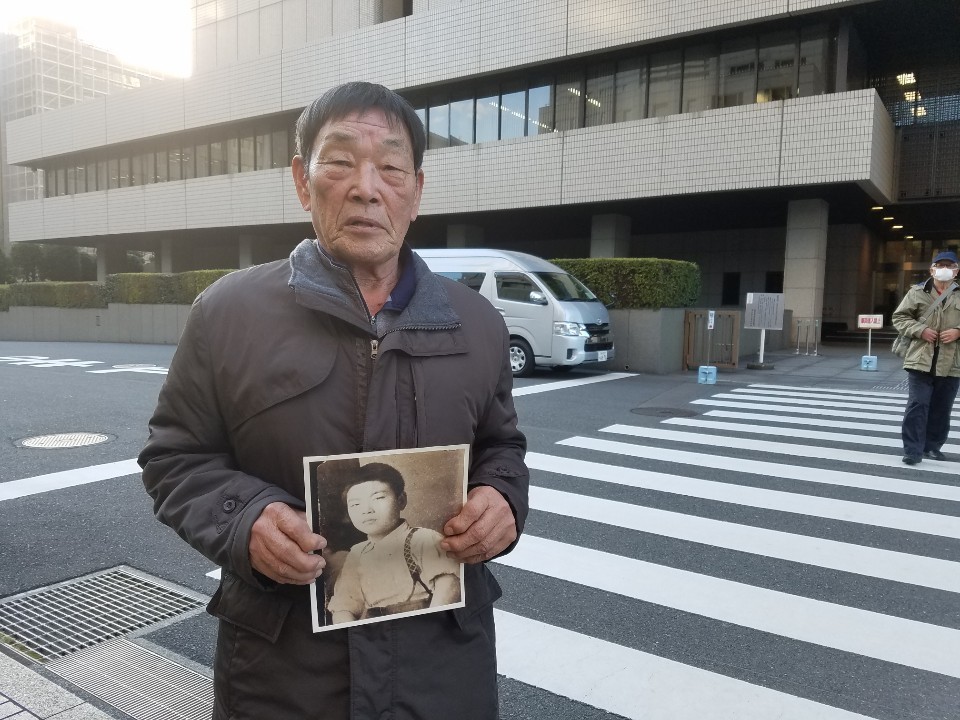 |
|
On Jan. 22, Yu Su-ye, 74, whose father suffered under Japan’s forced labor practices, holds up a photograph of his father in front of the Tokyo District Court after testifying in a lawsuit against the Japanese government for enshrining Korean victims with Japanese war criminals at Yasukuni. (Cho Ki-, Tokyo correspondent)
|
Victims have been enshrined with remains of Japanese war criminals
“My father was mobilized the day before I was born.” His heart aches to think of the father who left behind his pregnant wife and was dragged off to the battlefield without ever seeing his son’s face. Afterwards, a letter arrived from the father asking for a photograph of his newborn. “It said, ‘I want to see him. Please send me a picture at least. If I’d been taken away just a few days later I could have seen my son’s face,’” he recalled. Final arguments for a case demanding the abolition of improper joint enshrinement at the Yasukuni Shrine (which honors Japan’s war dead, including several war criminals) were held on the afternoon of Jan. 22 in courtroom 103 at Tokyo District Court. Yu Su-ye, 74, had a tremor in his voice as he delivered a final statement of behalf of the 27 surviving family members who filed the lawsuit. According to Yu, his father Yu Bong-hak was taken away at the age of 23. Mobilized in January 1945 as a civilian worker at a naval base in Kagoshima Prefecture, the elder Yu died in a US bombing attack the following July 28 – just 20 days before liberation. Yu had been an only son, and his family members scattered in all directions after he was mobilized. Yu Su-ye and his mother and grandmother managed to survive on rations. After liberation, villagers who had been mobilized with the father returned and told the family of his death. Beset with shock, the grandmother passed away a month later. “I never received a notice that he had died in the war. The records for my father [drafted by the Japanese government] said his remains had been returned to his family, but we never received them,” said Yu. Yu eked out a living shining shoes and selling gum. At times, he even contemplated suicide, he said. “Life was too hard,” he recalled. Yu explained that he could not bear to see his war victim father’s name remaining at Yasukuni Shrine. “The Japanese government and Yasukuni need to apologize to me and provide compensation for dragging my father off to a tragic death on the battlefield and then enshrining his remains without notice,” he said. “I want my father’s name removed from Yasukuni immediately.” Established in 1869, Yasukuni Shrine houses the enshrined remains of combatants from the Sino-Japanese, Russo-Japanese, and Pacific Wars, as well as the Class A war criminals who prepetrated the Pacific War. Also present are the remains of soldiers who died while suppressing volunteers in the Korean independence movement. Over 20,000 Koreans were enshrined there after being dragged off to the battlefield and their eventual deaths. Japan cites “religious freedom” as justification The family members filed an initial suit against Yasukuni and the Japanese government in 2008 to demand an end to their relatives’ enshrinement, but lost the case in 2013. The plaintiffs demanded answers on why the Japanese government had provided a list of war dead to Yasukuni, which had been reclassified as a religious corporation after the war. But the court ruled against them, concluding that actively protecting Yasukuni had not been the government’s intention or aim. Other family members filed a second suit with Tokyo District Court in 2013. Final arguments were held on Jan. 22, with a ruling expected in May. During the trial, the family members’ attorneys noted, “While [the Japanese government] claims that other countries also mourn their war dead, Yasukuni is different because it is a facility that affirms a war of aggression.” “No countries object to the memorial ceremonies the Japanese government holds for its war dead at Budokan on Aug. 15,” they added. The attorneys also said, “The Japanese government claims the provision of a list of war dead to Yasukuni was nothing more than an administrative service, but that does not stand to reason.” “Imagine the situation was turned around and it was Japan[ese citizens] dragged off to die on the battlefield after annexation by Korea,” they argued. “Would it be seen as acceptable for Korea to enshrine those Japanese people in religious facilities as the Korean government saw fit? Could they claim that as ‘religious freedom’?” they asked. By Cho Ki-weon, Tokyo correspondent Please direct comments or questions to [english@hani.co.kr]






